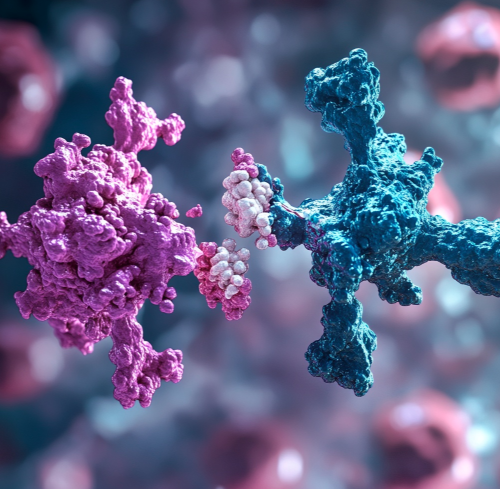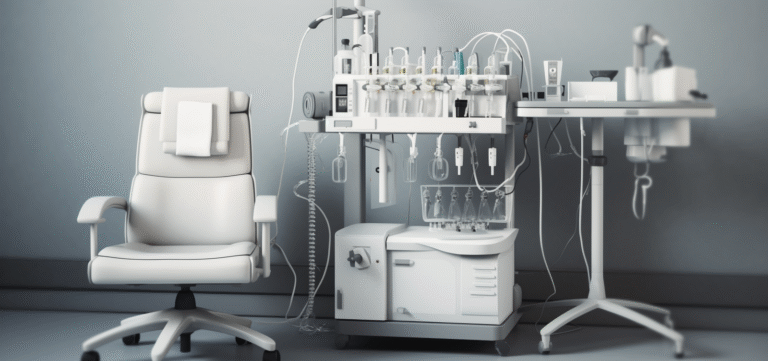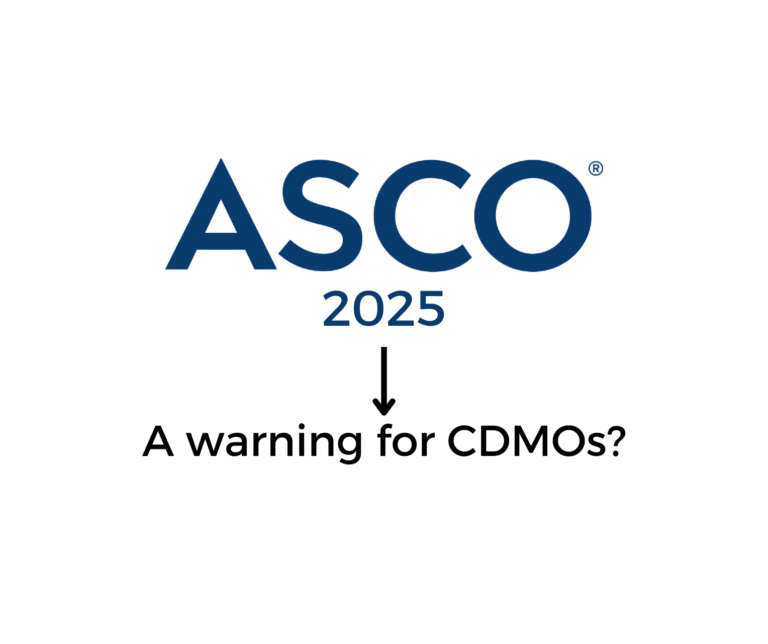The flood of clinical data and therapeutic breakthroughs from the ASCO 2025 Annual Meeting has subsided. But for leaders in the Contract Development and Manufacturing Organization (CDMO) space, the most critical takeaways weren’t just about the new drugs. The real story, lurking behind the headlines on AI and antibody-drug conjugates (ADCs), is a fundamental transformation in the very structure of biopharmaceutical development.
Trial timelines are compressing at an unprecedented rate. Drug delivery models are being reimagined. And the operational and technological demands placed on manufacturing partners are evolving faster than most are prepared for.
For years, CDMOs have operated on a relatively stable paradigm: receive a tech transfer package, execute on a statement of work, and manufacture at scale. That model is now obsolete. The data from ASCO 2025 is a clear warning shot: CDMOs that cannot match the new pace of innovation – marked by speed, precision, and flexibility – will quickly become the primary bottleneck in drug development. They will start losing business this year.
This impact brief unpacks the tectonic shifts from ASCO 2025, moving beyond the clinical outcomes to analyze the direct strategic, operational, and talent implications for CDMOs. If you are still waiting to react, you are already behind.
1. The New Clinical Development Paradigm: Speed and Agility Are Non-Negotiable
The most disruptive forces for CDMOs emerging from ASCO 2025 are not new molecules, but new processes. Artificial intelligence and adaptive trial designs are no longer theoretical concepts; they are actively reshaping how clinical trials are designed, executed, and monitored. This has profound consequences for manufacturing partners.
AI Compresses the Timeline, Exposing Manufacturing Lag
For decades, the clinical trial design and startup phase has been a protracted, manual process. ASCO 2025 signaled the end of that era.
- AI-Driven Protocol Design: Medidata’s launch of its Protocol Optimization tool is a case in point. By using AI to model the impact of protocol design choices on patient burden, site performance, and cost before the first patient is enrolled, sponsors can now trim trial preparation timelines by 30-40%. This tool preemptively identifies and resolves the kind of complex amendments that cause costly delays.
- The CDMO Implication: If a sponsor can finalize a trial-ready protocol in weeks instead of months, but your tech transfer, process validation, and material procurement process still takes a full quarter, you are now the bottleneck. The slow, static SOWs and sequential onboarding processes that have defined CDMO engagement are no longer viable.
- AI-Powered Predictive Biomarkers: The validation data for Onc.AI’s Serial CTRS imaging model was another landmark. The model proved superior to the long-standing RECIST 1.1 criteria in predicting overall survival, identifying non-responding patients months earlier than conventional methods. Biotechs are already beginning to design trials around this new capability.
- The CDMO Implication: This shift demands that CDMOs plug into the development cycle much earlier. Manufacturing can no longer wait for a finalized protocol to be handed over. Instead, CDMOs must be prepared to engage in strategic discussions about manufacturability and supply chain planning concurrently with AI-driven trial modeling. The ability to forecast demand for different formulations or doses in an adaptive trial is now a required competency.
Adaptive and Decentralized Trials Become Mainstream
The clinical presentations at ASCO were rife with examples of adaptive trial formats. Several studies utilized modular cohorts, real-time biomarker re-stratification, and mid-study design shifts to accelerate their path to a conclusive result.
- The CDMO Implication: The era of locking in large-scale, fixed batch runs for a multi-year clinical trial is over. Adaptive designs require flexible and responsive capacity models. CDMOs must be able to pivot quickly, producing smaller, variable batches to support different arms of a study, accommodate real-time adjustments in dosing, or even switch formulations mid-stream. This requires investment in modular cleanrooms, single-use technologies, and sophisticated scheduling systems that prioritize agility over sheer volume.
2. The Modality and Delivery Revolution: New Demands on Manufacturing
Alongside the changing process of drug development, the products themselves continue to grow in complexity. ASCO 2025 highlighted advancements in drug delivery and sophisticated therapeutic modalities that place new and significant technical demands on manufacturing partners.

Wearable Delivery and the Rise of Combination Products
One of the most talked-about presentations on patient experience came from Sanofi and Enable Injections. Their data on administering Sarclisa via the enFuse® on-body injector showed that treatment administration time could be reduced from over three hours to under five minutes.
- The CDMO Implication: This is not just a patient convenience issue; it is a manufacturing capability issue. Biopharma companies are increasingly seeking to differentiate their products through delivery innovation. CDMOs without proven expertise in device-fill, aseptic assembly, and the regulatory pathway for combination products will be systematically cut from the shortlists for these next-generation therapies. This capability is no longer a “nice to have” – it is a core requirement for a growing segment of the oncology market.
The Unrelenting Complexity of Next-Gen Oncology
The pipelines showcased at ASCO 2025 were dominated by highly complex modalities that carry significant manufacturing hurdles.
- Antibody-Drug Conjugates (ADCs): With practice-changing data from drugs like Enhertu and Trodelvy, the ADC space is hotter than ever. Manufacturing these agents requires not only expertise in monoclonal antibody production but also specialized high-containment facilities for handling highly potent cytotoxic payloads, mastery of complex conjugation and purification chemistry, and advanced analytical methods to characterize the final product.
- Bispecific and Multispecific Antibodies: Agents like Rybrevant and Imdelltra highlight the clinical success of molecules engineered to hit two or more targets. However, their complexity leads to significant manufacturing challenges in ensuring correct chain pairing and purifying the desired product away from a host of closely related impurities, demanding advanced chromatography skills and deep process understanding.
- Cell Therapies: Kite’s presentation on the dual-target CAR-T, KITE-363, is indicative of the innovation in cell therapy. For CDMOs, this field requires managing complex “vein-to-vein” logistics, securing a reliable supply of GMP-grade viral vectors, and navigating the inherent variability of patient-specific manufacturing.
- The CDMO Implication: The technical barrier to entry for cutting-edge oncology manufacturing is rising. CDMOs must make strategic decisions about where to specialize. Spreading investment too thin will result in mediocrity across the board. Success requires focused investment to achieve true mastery in one or more of these high-growth, high-complexity areas.
3. The Widening Talent Gap: A Critical Strategic Risk
The rapid evolution in technology and therapeutic modalities has created a critical talent shortage. ASCO sessions and corridor conversations repeatedly flagged the scarcity of professionals with the specific, cross-functional skills needed to enable next-generation oncology trials. CDMOs are at the epicenter of this talent crisis.
Three roles, in particular, represent the most significant hiring gaps:
- AI-Literate MSAT Leads: The Manufacturing, Science, and Technology (MSAT) function is the bridge between development and the plant floor. As sponsors adopt AI for trial design and process modeling, MSAT leaders must be able to speak that language. They need to integrate data from disparate digital sources, implement predictive models for process control, and translate AI-driven insights into actionable manufacturing protocols. A traditional MSAT background is no longer sufficient.
- Formulators with Combination Product Experience: As the Sanofi/Enable example shows, the future involves integrating drugs with devices. This requires formulation scientists who understand not just protein stability, but also material science, device engineering, human factors, and the unique regulatory requirements for combination products. This is a rare and highly sought-after skill set.
- Bioanalytical Scientists Fluent in Novel Biomarkers: When a trial’s inclusion criteria and endpoints are based on a novel AI-derived imaging biomarker (like Onc.AI’s CTRS), the bioanalytical methods that support the trial must be equally advanced. This requires scientists who can develop, validate, and run novel potency assays and characterization methods that reflect these new mechanisms of action.
For CDMOs, failing to recruit or upskill talent in these areas is not just a human resources issue; it is a direct threat to their ability to compete for and execute on the most advanced projects.
4. Strategic Imperatives for CDMO Leadership: From Reactive Vendor to Proactive Partner
The convergence of these trends from ASCO 2025 presents a clear choice for CDMO leaders: evolve or risk obsolescence. The path forward requires a fundamental shift from a reactive, fee-for-service vendor to a proactive, integrated strategic partner.
This requires decisive action in three key areas:
- Invest in Digital and Modular Infrastructure: The time for paper-based tech transfer is over. CDMOs must invest in digital platforms that can seamlessly interface with sponsor systems. They must also reconfigure their physical infrastructure to support flexible, modular manufacturing that aligns with the needs of adaptive clinical trials.
- Build Deep, Specialized Expertise: CDMOs can no longer be generalists. Leadership must make focused, strategic bets on which complex modalities to master. Whether it’s becoming a center of excellence for ADC conjugation, bispecific purification, or combination product finishing, deep expertise in high-demand areas will command premium value.
- Solve the Talent Equation, Proactively: The most forward-thinking CDMOs will build internal academies to upskill their existing workforce and forge partnerships with academic institutions to create a pipeline for the new roles they need. Waiting for perfect candidates to appear on the market is a losing strategy.
ASCO 2025 was more than just another scientific meeting. It was a glimpse into a future where the speed of innovation is dictated by the seamless integration of data, technology, and manufacturing. The CDMOs that will thrive in this new landscape are those that recognize this shift today and begin transforming their operations, their capabilities, and their talent base to meet the challenge. The warning has been fired; the time to act is now.
Hiring in CDMO? Need some guidance/advice? Click here to talk to us directly: www.progensearch.com/talk-to-uk






